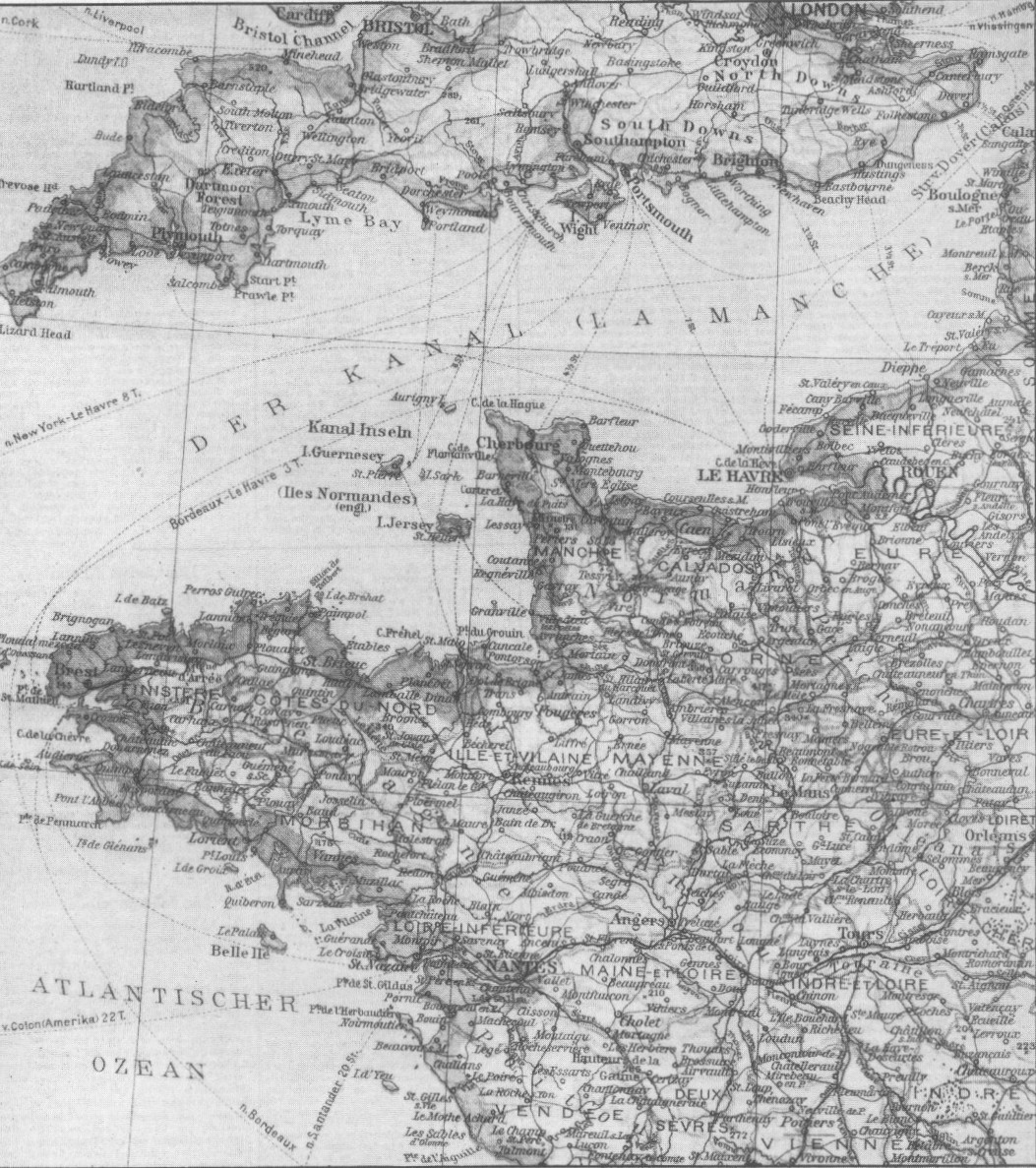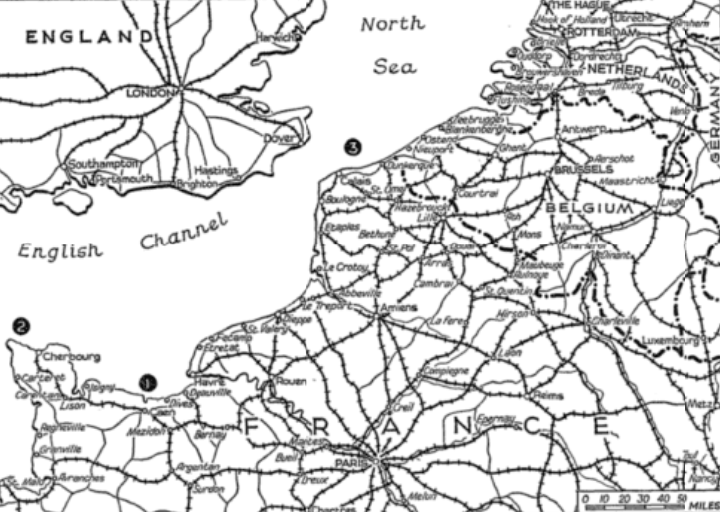WAR BULLETINS!
Adm. King: Invasion ‘doing all right’
Washington (UP) –
Adm. Ernest J. King, commander of the U.S. Fleet, said after a conference with President Roosevelt today that the invasion of Europe is “doing all right so far.”
Channel battle reported by Germans
London, England (UP) –
The German Transocean News Agency said today that a battle was in progress in the English Channel north of Le Havre between German naval units and Allied forces attempting to make a landing.
See Red drive before weekend
London, England (UP) –
Military observers said today a general Russian offensive coordinated with the Anglo-American attack from the west may be launched within the next 48 hours and almost certainly will begin before the weekend.
Russians celebrate Allied landing
Moscow, USSR (UP) –
News of the Allied landing in France spread swiftly throughout Russia today and touched off enthusiastic demonstrations such as rarely have been seen since the war began. Soviet war marches, “Yankee Doodle” and the triumphal music reserved for Stalin’s victory orders followed the announcement.
Berlin: Allies hold firm bridgeheads
Radio Berlin, monitored by NBC, has admitted bridgeheads between Le Havre and Boulogne are now firmly in Allied hands. The Berlin radio added the Allies have landed heavy armament on the beachheads.
Naval guns bombard French beaches
London, England (UP) –
More than 640 naval guns, ranging from four-inch to 16-inch, are bombarding the French beaches and enemy strongpoints in support of the Allied armies, Allied Supreme Headquarters announced today.
Allies suffer heavy reverses, Nazis claim
London, England (UP) –
The German High Command in its first invasion communiqué today said Allied forces suffered “particularly heavy reverses” in the Caen area of northern France and claimed that an entire regiment of paratroopers was destroyed in that sector.
Nazis report 80 Allied warships in the Orne
London, England (UP) –
The German Transocean News Agency said today that about 80 medium-sized Allied warships were approaching the town of Ouistreham in the estuary of the Orne River.
OWI warns against German broadcasts
Washington (UP) –
Americans were warned today by Director Elmer Davis of the OWI that despite the Germans’ accuracy in announcing the invasion prior to the official Allied communiqué, German broadcasts should not be relied on in the future.
Pershing confident of victory
Washington (UP) –
Gen. John J. Pershing, who led U.S. troops to victory in World War I, called on his countrymen today to share his “every confidence” that American manhood again “will win through to victory” in their second great contest on Western European soil.
Nazis: Allied warship afire in Seine
London, England (UP) –
The German Transocean News Agency said today that a large Allied warship had been set ablaze in the Seine estuary by artillery fire.
More Allied troops landed, Germans report
London, England (UP) –
The German news agency DNB said today the allies had landed “further reinforcements” by sea and air in the Seine estuary.
Nazis admit Allied grip on French isles
London, England (UP) –
The German Transocean News Agency acknowledged today that the Allies had gained footholds on several islands off the coast of France.
German artillery opens up with salvoes
London, England (UP) –
German coastal artillery in France opened up with salvoes across the Channel soon after noon today, shaking towns in Southeast England.
Not one Nazi coastal gun firing
An NBC reporter, who flew over 20 miles of the invasion coast this morning, reports that “not a single German coastal gun was firing in the entire invasion zone,” indicating that we have completely knocked out the initial line of defenses of the much-vaunted Atlantic Wall.
Allied airborne toll light, leaders say
London, England (UP) –
Casualties among Allied airborne troops in France have been light, Supreme Headquarters Allied Expeditionary Forces announced today.
‘They can’t stop us’ is the watchword as invasion opens
By Sandor S. Klein
Washington (UP) –
An American sergeant, packing concentrated destruction, peered into the darkness toward France and said, “They can’t stop us.”
His four words, from an “invasion front” dispatch to the War Department, were uttered as the greatest military operation of history began “very quietly and without tension” from a small British town whose inhabitants had little idea that anything unusual was going on.
From this town, the War Department dispatch said, the liberation of Nazi Europe “began in a small way” as assault troops – relieved of practically everything but weapons – walked calmly aboard their blunt-nosed landing craft “without attracting the slightest bit of attention.”
Thus started what in a matter of hours became a roaring, flaming, crashing inferno as the battle was joined on the northern coast of France and Allied airplanes swarmed against any targets, however small, which might have “a bearing on the strength of the armies…”
The men had been briefed carefully. They knew exactly what their mission was. At the last moment, the War Department dispatch said, they were relieved of “practically everything except their arms and ammunition.”
Picked Yanks spearhead attack, blast way through vaunted wall
Washington (UP) –
Specially trained, picked assault teams of the U.S. Army made the initial attack on Fortress Europe, knocking out pillboxes and other fortifications of the vaunted Atlantic Wall, the War Department said today.
Putting to use tactics perfected in North Africa, Sicily and Italy, the assault units hit the beach under cover of heavy naval and artillery fire.
These units, actually infantrymen, were given special training to spearhead the massive assault. These men were equipped with special engineer weapons.
Preparation for the assault was provided by artillery, by naval guns, by air bombardment and by waterproof tanks firing hull-down in the water.
The purpose of this is not only to knock out pillboxes but to tear up the enemy’s field of fire by providing shell craters as cover for attacking units.
First men clear mines
Each assault section is composed of 30 men – one officer, and 29 G.I. Joes. This is the capacity of the assault boats, and it is also the most convenient size unit for a single pillbox.
It is the job of the first men ashore to locate the mines, and mark safe lanes with special tracing strips. As part of this operation, the wire itself must be cut, and American soldiers have an efficient weapon for this purpose.
It is the Bangalore torpedo, which comes in long sections capable of being made into any length necessary, depending upon the depth of the barbed wire.
One member of the assault team, under cover of small arms, fixes the Bangalore, sets the fuse, and ducks for cover. The torpedo explodes with a terrific blast, blowing a wide swath through the wire. The other members of the team follow through the wire and move up the beach.
Composed of seven teams
An assault section is composed of seven separate teams of varying sizes, beginning with the riflemen who build up a line of fire to protect the others.
They are followed by wire cutters who clear out wire not blown by the Bangalores. Next in line is the Browning automatic rifle team, whose mission is to deliver fire on portholes of the emplacement and keep the heads of the enemy down.
Then there is the next team – the gunners, firing the famous bazooka rockets. Their mission is to attack the pillbox and aperture to silence enemy fire.
The climax of the entire operation is played by the soldier with flamethrower and the man with the demolition charge. These are engineer weapons, but the infantrymen have become proficient in their use.
‘Pole charges’ do trick
The final assault is accomplished by the demolition men, equipped with what are known as “pole charges.”
The “pole charge” is a device resembling an ordinary bricklayer’s hod, and upon it is placed a block of TNT. The purpose of this design is to enable the demolition men to lean the charge against the pillbox aperture.
As soon as the pillbox blows up, the entire section moves forward for another attack. During a landing operation, these tactics are repeated by many squads along a considerable front.

